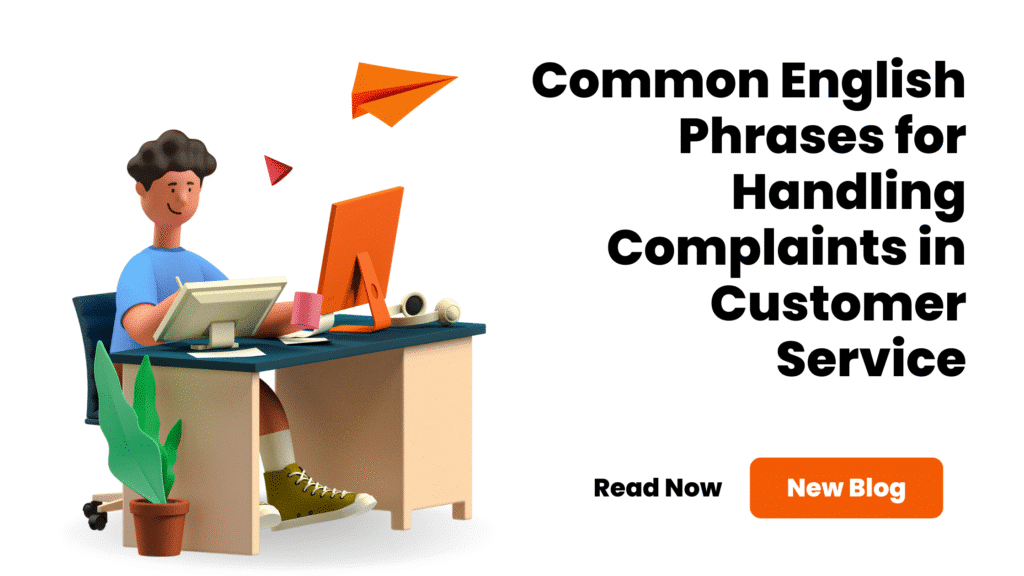Handling complaints is one of the trickiest parts of customer service—especially if you’re speaking English as a second language. Whether you’re working at a front desk, managing emails, or chatting online with customers, knowing the right English phrases can help you stay professional, calm, and in control of the situation.
This guide is packed with practical phrases and strategies to help you manage customer complaints in English with confidence. You’ll learn how to apologise, offer solutions, show empathy, and stay polite—even if the customer is angry or upset.
If you’re just getting started, you may want to check out our earlier blog on Customer Service Vocabulary for Non-Native Speakers or try some customer service role-play scenarios to practice these phrases in action.
Why Phrases Matter When Handling Complaints
In customer service, the words you choose can either calm a customer down or make them even more upset. Having a toolbox of go-to phrases helps you:
- Sound professional and confident
- Keep the conversation polite
- Avoid misunderstandings
- Focus on solutions, not just problems
Let’s look at the most common types of phrases used when handling complaints.

1. Phrases for Acknowledging the Complaint
This is the first and most important step—showing the customer that you’ve heard them. It builds trust and sets a positive tone.
Useful phrases:
- “Thank you for letting us know.”
- “I can understand how that would be frustrating.”
- “Thanks for bringing this to our attention. Let’s look into it.”
- “I completely understand your concern.”
If you’re not clear on the issue, ask for clarification:
- “Could you please explain a bit more about what happened?”
- “Just so I’m clear, you’re saying the delivery was delayed by three days, correct?”
2. Phrases for Apologising
Even if the problem wasn’t your fault personally, offering a sincere apology shows you care about the customer’s experience.
More examples:
- “I’m really sorry this has happened.”
- “Please accept our apologies for the inconvenience.”
- “That definitely shouldn’t have happened—we’ll make it right.”
These show empathy without taking blame for things outside your control.
3. Phrases for Explaining the Situation
Customers want answers. But don’t overload them with technical details—be honest and brief.
Examples:
- “There was a miscommunication between our warehouse and delivery team.”
- “Unfortunately, there was a delay from our supplier.”
- “We had a system outage that affected some orders, including yours.”
Helpful additions:
- “We’ve fixed the issue and it shouldn’t happen again.”
- “I appreciate your patience while we resolve this.”
4. Phrases for Offering Solutions
This is your chance to turn the situation around. The right solution, combined with the right language, can make a big difference.
Common solutions:
- “Would you prefer a refund or an exchange?”
- “We can send you a replacement immediately.”
- “We’ll credit your account with a discount for your next order.”
Other options:
- “Let me confirm the new shipping date for you.”
- “I’ll personally make sure this gets resolved.”
Always double-check:
- “Is this acceptable for you?”
- “Would that work for you?”
5. Phrases to Stay Calm with Difficult Customers
When emotions run high, stay calm. Speak clearly and avoid emotional responses.
Useful phrases:
- “Let’s work together to fix this.”
- “I want to help you, but I need you to stay calm so we can talk about it.”
- “I understand you’re upset. Let’s find a solution.”
If things escalate:
- “I’ll transfer you to a supervisor who can assist further.”
- “If it’s okay with you, I’d like to take a moment and review your issue more thoroughly.”

6. Phrases for Wrapping Up the Complaint
Once you’ve addressed the issue, leave a good final impression.
Examples:
- “Thanks for your patience and understanding.”
- “We’re happy we could resolve this.”
- “If anything else comes up, please let us know.”
Follow-up reassurance:
- “You’ll receive a confirmation email shortly.”
- “I’ll check in with you tomorrow to make sure everything’s okay.”
7. Phrases to Use in Emails or Live Chat
If you’re working in written support, clarity and tone are key. Keep it polite, professional, and easy to understand.
Starting the message:
- “Thanks for reaching out to us.”
- “I’m sorry to hear about your experience.”
Middle:
- “I’ve reviewed your account and here’s what I found.”
- “We’re currently processing your refund.”
Ending:
- “Let me know if you have any other questions.”
- “Thanks again for your patience.”

8. Real-Life Scenario & Dialogue Breakdown
Let’s look at a typical customer service complaint and how you might respond.
Scenario: A customer didn’t receive the correct item in their order.
Customer:
“I ordered a black hoodie in size large, but I received a red one in medium. This is ridiculous!”
You:
“I’m so sorry about that. Let me look into your order right away.”
Customer:
“I don’t have time for this—this is very frustrating.”
You:
“I completely understand. I’d feel the same in your position. I’ll take care of it for you.”
You (after checking):
“It looks like there was a packing error on our side. I’ll send the correct item today, and we’ll include a return label for the wrong one. Would that work for you?”
Customer:
“Yes, fine.”
You:
“Thanks for your understanding. You’ll get a tracking number shortly. Let me know if there’s anything else I can help with.”
This style of response uses empathy, offers a solution, and ends on a helpful note. Try practising similar dialogues with a partner or colleague.
9. Body Language and Tone Tips for Handling Complaints
In person or on video calls, what you say matters—but so does how you say it.
Helpful tips:
- Keep your voice calm and even—avoid sounding defensive or rushed.
- Use open body language—don’t cross your arms or look away.
- Smile when appropriate—it can make your tone warmer, even over the phone.
- Don’t interrupt—let the customer speak without cutting in.
- Nod occasionally (if in person) to show you’re listening.
For ESL speakers, recording yourself practicing tone can be helpful. You want to sound calm, helpful, and human—not like you’re reading a script.

10. Extra Phrases to Learn
Here are a few more handy phrases that are common when handling complaints:
- “Let’s get this sorted out quickly.”
- “I’ll make this my top priority.”
- “Thanks for giving us the chance to fix this.”
- “We value your feedback—it helps us improve.”
Final Thoughts
Handling complaints isn’t about being perfect—it’s about being prepared. With the right English phrases and a calm, confident tone, you can turn a frustrated customer into a loyal one.
If you’re new to customer service or just looking to improve your English, these phrases will help you stay in control and show professionalism in every situation.
Keep practicing, and don’t forget to check out more helpful content on our site to level up your customer service skills.



